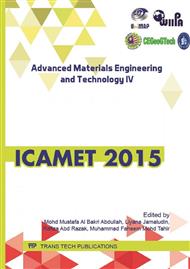[1]
Sharif, A., Chan, Y. C. Dissolution kinetics of BGA Sn–Pb and Sn–Ag solders with Cu substrates during reflow. Mater Sci Eng B 2004; 106: 126–31.
DOI: 10.1016/j.mseb.2003.09.004
Google Scholar
[2]
Yoon, J. W., Kim, S. W., Jung, S. B. IMC growth and shear strength of Sn-Ag-Bi-In/Au/Ni/Cu BGA joints during aging. Mater Trans 2004; 45: 727–33.
DOI: 10.2320/matertrans.45.727
Google Scholar
[3]
Suganuma, K. Advances in lead-free electronics soldering. Current opinion in solid state & material science. 2001; 5: 55–64.
DOI: 10.1016/s1359-0286(00)00036-x
Google Scholar
[4]
Noh, B. I., Choi, J. H., Yoon, J. W., Jung, S. B. Effects of cerium content on wettability, microstructure and mechanical properties of Sn–Ag–Ce solder alloys. J Alloys Compd 2010; 499: 154–9.
DOI: 10.1016/j.jallcom.2010.03.179
Google Scholar
[5]
Wu, C. M. L., Yu, D. Q., Law, C. M. T., Wang, L. Properties of lead-free solder alloys with rare earth element additions. Mater Sci Eng R 2004; 44: 1–44.
DOI: 10.1016/j.mser.2004.01.001
Google Scholar
[6]
McDonald, S., Nogita, K., Read, J., Ventura, T., Nishimura, T. Influence of composition on the morphology of primary Cu6Sn5 in Sn–4Cu alloys. J Electron Mater 2013; 42: 256.
DOI: 10.1007/s11664-012-2222-3
Google Scholar
[7]
Abtew, M., Selvaduray, G. Lead-free solders in microelectronics. Mater. Sci. Eng R 2000; 27, 95-141.
DOI: 10.1016/s0927-796x(00)00010-3
Google Scholar
[8]
Park, J. Y., Kang, C. S., & Jung, J. P. The analysis of the withdrawal force curve of the wetting balance curve. IEEE T COMP, 22(3), 1999, pp.174-180.
DOI: 10.1109/6144.796538
Google Scholar
[9]
Harris, P. G., & Chaggar, K. S. the role of intermetallic compounds in lead-free soldering. Soldering Surf. Mount Technol. 10(3): 38-52, (1998).
DOI: 10.1108/09540919810237110
Google Scholar
[10]
Chen, K. I., Cheng, S. C., Cheng, C. H., Wu, S., Jiang, Y., & Cheng, T. (2014). The Effects of Gallium Additions on Microstructures and Thermal and Mechanical Properties of Sn-9Zn Solder Alloys, (2014).
DOI: 10.1155/2014/606814
Google Scholar


